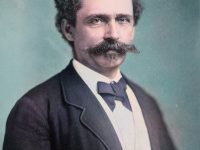
Jean de Thévenot (1633 – 1667)
On June 16, 1633, French traveller, linguist, natural scientist and botanist Jean de Thévenot was born. A curious and diligent observer Thévenot was traveling through Asia and wrote extensively about his journeys.
“There are many in Christendom who believe that the Turks are great devils, barbarians, and men without faith, but those who have met them and talked with them are of quite a different opinion; for it is certain that the Turks are good men, who act very well according to the commandment which nature gives us, that we should do unto others only as we would have them do unto us.”
– Jean de Thévenot
Jean de Thévenot – Becoming a Traveler
Born in Paris, France, Jean Thévenot was the nephew of the collector of travelogues and later director of the Bibliothèque Royale, Melchisédech Thévenot (ca. 1620-1692). He received his education at the College of Navarre. The study of travelogues by other travelers prompted him to go abroad himself, which his circumstances allowed him to do. He left France in 1652 and traveled first to England, the Netherlands, Germany and Italy. In Rome he met the orientalist Barthélemy d’Herbelot de Molainville, who invited him to become his companion in a planned trip to the Levant. D’Herbelot was held back by private affairs, but Thévenot sailed from Rome in May 1655. After waiting in vain for d’Herbelot for five months on Malta, he traveled on alone to Constantinople.
African Travels
Thévenot remained in Constantinople until the end of August of the following year and then traveled on to Smyrna, across the Greek islands, and finally to Egypt, where he arrived on January 1, 1657. He remained in Egypt for a year, then toured the Sinai and, after returning to Cairo, joined a pilgrimage train that walked to Jerusalem during Lent. He visited the most important pilgrimage sites in Palestine and, after being attacked twice by corsairs, traveled by ship to Damiette, Egypt, so that he was back in Cairo on August 14, 1658, at the time of the Nile flood.
In January 1659 he sailed on from Alexandria in an English ship, called at the Tunisian ports of Tunis and La Goletta, got into a naval fight with Spanish pirates, from whom one ship was taken as a prize by an English merchant ship, and finally reached Livorno on April 12. He then spent four years at home studying in preparation for further voyages, and in November 1663 he again traveled east toward Alexandria and from there on to Sidon, from where he continued overland to Damascus, Aleppo, and then through Mesopotamia to Mossul, Baghdad, and Mendeli in Kurdistan.
The Orient
Here he reached the border with Persia on August 27, 1664, and traveled on there via Kermānschāh Hamadan to Isfahan, where he spent five months (October 1664 to February 1665) before joining the jeweler and traveling salesman Jean-Baptiste Tavernier, with whom he traveled via Shiraz and Lar to Bandar Abbas, where he hoped to find a ship passage to India. Although Tavernier made good progress along the way, resistance from the Dutch was to be expected, so de Thévenot thought it wiser to choose another route. He returned to Shiraz, visited the ruins of Persepolis, and reached Basra, from where he sailed on the ship Hopewell on November 6, 1665. He reached Surat, India, on January 10, 1666.
The End of the Journey
Thévenot stayed in India for thirteen months, crossing the country from Surat via Golkonda to Masulipatam (Machilipatnam) and returning, also by land, to Surat, from where he sailed to Bandar Abbas and traveled on to Shiraz. He had to spend the summer of 1667 in Isfahan, as he was seriously wounded by an accidental pistol shot; nevertheless, he ventured on to Tabriz in October, but died on the way there near Miyana on November 28, 1667.
A Promoter of the Coffee Bean
Thévenot was an excellent linguist who mastered Turkish, Arabic and Persian and was a curious and careful observer. He also had talents in the natural sciences, especially botany, so much so that he also assembled a significant botanical collection in India. In particular, he popularized the coffee bean in France. His works are still appreciated today, although it has been justly noted that, unlike Jean Chardin, he only recognized the facade of Asian life.
Publications
The description of his first voyage was published in Paris in 1665; it represents the first part of his collected Voyages. The book received the printing privilege in December 1663. The introduction proves that Thévenot himself compiled the account for publication before embarking on his second voyage. The second and third parts were compiled from his travel diaries after his death and published as quarto volumes in 1674 and 1684, respectively.
Arjaan Pellis, History of tourism before industrialisation | WURcast, [6]
References and Further Reading:
- [1] Glenn Sundeen: Thévenot the Tourist: A Frenchman Abroad in the Ottoman Empire. In: Distant Lands and Diverse Cultures: The French Experience in Asia, 1600-1700, Greenwood Publishing Group, 2003.
- [2] Dew, Nicholas (July 2012). “Les Voyages aux Indes Orientales, and: Voyage en Europe 1652-1662 (review)”. French Studies: A Quarterly Review. 66 (3): 393–394
- [3] Thévenot, Relation d’un voyage fait au Levant. Paris: L. Billaine, 1665.
- [4] Chisholm, Hugh, ed. (1911). “Thévenot, Jean de“. Encyclopædia Britannica. 26 (11th ed.). Cambridge University Press.
- [5] Jean de Thévenot at Wikidata
- [6] Arjaan Pellis, History of tourism before industrialisation | WURcast, WageningenX MOOC called ‘Sustainable Tourism: Society & Environmental Aspects’, WURcast @ youtube
- [7] Timeline of explorers of Africa, via Wikidata and DBpedia





